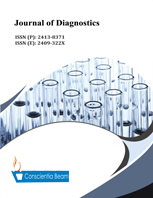Seroprevalence of Herpes Simplex Virus Type 2 (HSV-2) Infection Among HIV Patients Accessing Healthcare at Federal Medical Centre, Keffi, Nigeria
DOI:
https://doi.org/10.18488/journal.98/2016.3.2/98.2.31.37Abstract
Herpes simplex virus type 2 (HSV-2) infections is a sexually transmitted infection worldwide, which has a public health implications especially as a driving force behind the Human Immunodeficiency Virus (HIV) epidemic. It is known to cause genital ulcer as well as lesions. It is a lifelong recurrent disease with no cure. Due to the lack of documented HSV-2 studies among HIV patients in this study area with an estimated HIV prevalence of 38.7%, there was a need for estimating the seroprevalence of HSV-2 infection in the study population. The sera of 223 consenting HIV positive patients were screened for HSV-2 specific IgG using an ELISA test kit (Cortez Diagnostic, Inc, USA). The chi-square test was performed to identify possible risk factors associated with the viral seropositivity. The overall seroprevalence of the viral infection was 77.6%. Females recorded a prevalence of 84.5% and males 51.0% (p > 0.05). Participants aged ≤ 20 and ≥ 61 years recorded a prevalence of 100%, while the lowest prevalence (66.7%) was observed in those aged 51-60 years (p > 0.05). There was a statistically significant association between the seroprevalence of HSV-2 in HIV patients in relation to locality. Patients from the rural setting had a higher prevalence (85.2%) of the infection than those from the urban setting (72.6%) (p ≤ 0.05). However, in this study, marital status, occupation, level of education, antiretroviral therapy (ART) status and CD4 counts, had no statistically significant association with HSV-2 infection (p > 0.05). Awareness campaigns that will promote behavioral change might be the most important strategy to mitigate transmission as most of the infected persons usually show no clinical symptoms. The role of vaccination and condom use among high risk groups may help in combating the transmission.

